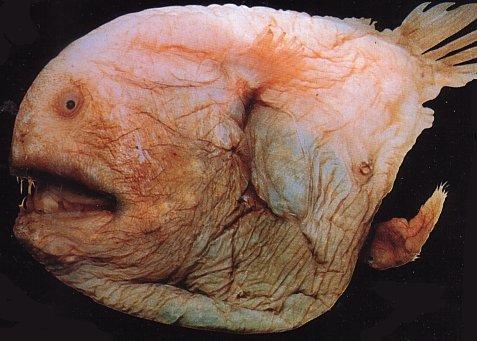



| هذه الصورة مصغره ... نقره على هذا الشريط لعرض الصوره بالمقاس الحقيقي ... المقاس الحقيقي 603x451 . |





This one is a robo-carp you can observe at the London Aquarium. It’s a
self-guided robot-fish who use artificial intelligence and sensors to
avoid obstacles . It’s a 50cm long common carp, swimming with their
living counterparts.
Deep-sea glass squid
A martian? No, it’s the glass squid. This odd looking creature is
located in the southern hemisphere and is the prey of many deep sea fish
(ex: goblin sharks), whales and oceanic seabirds.
Snaggletooth
Science experiment gone wrong? Sadly this is not the case. The
Snaggletooth or Astronesthes slightly resembles the South American
Payara without the charcoal finish and lack of scales. The Snaggletooth
is a powerful predatory fish who resides in the deep waters between
Australia and New Zealand. Sorry, the snaggletooth isn’t part of our fishing
tournament
Axolotl

You can learn more on this amphibian called axolotl on http://www.e-msjed.com/msjed/site/download.asp?topicid=1130&dlink=http://www.axolotl.org/
. This one is in the same family than the tiger salamander. The only
place on earth you can find those one are at Lake Xochimilco in Mexico.
Mudskipper

The
mudskipper are special kind of fish that live most of their life on land
beside than into the water. They are located in the Indo-Pacific as
well than in the Atlantic coast of Africa. Mudskippers are quite active
when out of water.
Slander Lanternfish

The
slender lanternfish are so abondant in the ocean that some people
pretend they are the most common fish in the sea. Lanternfishes are
recognised by their small light organs dotted along the undersides of
their bodies.
Deep-sea stargazer

Stargazers
are a family of muscular bulldog-like fishes that typically bury in the
seafloor and ambush passing prey. Stargazers are the ultimate ambush
predator, with the eye sets on top of the head allowing it to be almost
completely hidden. This is combined with an electrical capability which
can be used to stun its prey.
Giant Hatchetfish

The
giant hatchetfish is found in deep tropical and subtropical waters of
all oceans, except the north Pacific. Its length is between 8 and 12 cm.
The giant hatchetfish is a deep-bodied species with large eyes that are
directed upwards, enabling prey to be silhouetted against the faint
light coming from the surface, and a large mouth also directed upwards.
Dumbo Octopus

The
deep-sea “Dumbo” octopus got its nickname from the ear-like fins
protruding from the top of their “heads” (actually bodies), resembling
the ears of Walt Disney ’s flying elephant . They are benthic creatures,
living at extreme depths, and are some of the rarest of the Octopoda
species.
Eelpout

The
eelpouts are a family of perciform ray-finned fish They are found in
Arctic and Antarctic.
Black-lip Rattail

These
sorts of rattails feed in the muddy seafloor by gliding along head down
and tail up, powered by gentle undulations of a long fin under the
tail. The triangular head has sensory cells underneath that help detect
animals buried in the mud or sand. The common name comes from the black
edges around the mouth.
Humpback Anglerfish

This
black seadevil, of the size of a tennis ball, is one of the weirdest
fish in the world. Female humpback anglers have an enormous head
dominated by a cavernous mouth full of long slender teeth that can fold
backwards when prey is being swallowed.
Coelacanth

They
are the oldest kind of fish we know on earth. They were believed to be
extinct before fisherman captured a couple of them in the 1930s.
Northern Seahorse

The
seahorse is also one of the top weird sea creature. The male are
carrying the egg in a special abdominal pouch, like you can see on the
picture.
Longhorn Cowfish

The
longhorn cowfish are found in the Indo-Pacific region. Their flesh is
poisonous and would not make for a very good meal !
Leafy Sea Dragon

Sea
Dragons are arguably the most spectacular and mysterious of all ocean
fish. Leafy Sea Dragons are very interesting to watch– the leafy
appendages are not used for movement. The body of a sea dragon scarcely
appears to move at all.
Lumpfish

The
longest lumpfish so far recorded from the American coast measured 23
inches, and weighed 13¼ pounds; the heaviest weighed 20 pounds but
measured only 21½ inches (both from Orient, N. Y.), and the proportion
of weight to length varies similarly in smaller fish.
Atlantic Wolffish

The
Atlantic Wolffish is a large bottom-dwelling predatory marine fish. The
species is widely distributed across the North Atlantic.
Lionfish

A
distinguishing feature of the Lionfish is its large fan-like pectoral
fins. They are potentially dangerous, not only to the smaller fish the
prey upon, but to humans, as well. The spines on its dorsal fins contain
a strong poison, which is perhaps one reason they are totally unafraid
of divers.
Deep-Sea Lizardfish
The Deep-Sea Lizardfish, is a
member of the Synodontidae family, it is found throughout the world in
tropical and subtropical seas at depths of between 600 and 3,500 m. It
is considered as an ambush predator hunting in the abyssal seafloor and
devouring prey with its razor sharp barbed teeth.
Fangtooth Fish
The Fangtooth fish is found in midwater depths of about five
kilometers (three miles). They are extremely muscular and their teeth
are so long that when the jaw is shut, the lower pair must slide into
special sheathes on either side of the fish’s brain to avoid impaling
it.

Check out this vicious fish devour it’s prey.
Black Chimaera

Chimaeras
are related to both sharks and rays. They are jawed fish with paired
fins, paired nostrils, scales, two-chambered hearts, and skeletons made
of cartilage rather than bone. Chimaeras grow up to two meters long, are
found in the ocean floors and have a venomous spine which they use for
defense purposes.
Clown Triggerfish

The
Clown Triggerfish or Big-spotted Triggerfish is one of the most
spectacular looking marine species. This species grows to 50 cm in
length and is usually found in the warm parts of the Pacific Ocean,
Indian Ocean and the Red Sea. Even though its appearance is quite
innocent; this fish is an aggressive carnivore that primarily preys on
shelled invertebrates.
Longlure Frogfish

The
Longlure frogfish are found in tropical oceans and seas around the
world. They are small fish with large odd looking heads. They are mostly
bottom-dwelling fishes that are well camouflaged; they employ the first
dorsal spine as a fishing
lure to attract prey.
Prehistoric Frilled Shark
The Frill Shark can be recognised by its slender eel-like body, six
pairs of gill slits, terminal mouth, three-pronged teeth, single dorsal
fin, caudal fin without a lower lobe, and brown colour. This species
grows to a maximum length of about 2 m.
Checkout the frilled shark
that was caught off the coast of Japan!
Black Swallowe

The
black swallower (Chiasmodon niger) is a deep sea fish that has the
ability to extend its stomach 3 times its size so that it can swallow
fish that are bigger than itself. It can be found in deep seas up to
1,500 meters or in hot tropical waters. It creates its own light because
of the darkness found in some parts of the Pelagic zone. The black
swallower can grow up to 25 centimeters.
Mantis Shrimp

This
highly intelligent hunter with claws can lash out at prey with the
force of a gunshot. Larger varieties have been known to shatter glass or
sever human fingers. Most are either “spearers” (with sharp, mantidlike
claws) or “smashers” (with blunt, clublike claws for cracking
hard-shelled prey). Rare among invertebrates are the monogamous mating
habits that several species demonstrate. Mated pairs share a burrow, and
the male hunts for both his mate and young
<blockquote>
</blockquote>




























 مرحبا بك معنا ضيفا او عضوا عزيزا على منتدى اصحاب مدى الحياه. يمكنك المشاركة في المنتدى عن طريق تقديم المقالات والمواضيع المفيدة والردود البناءة. منتدى اصحاب مدى الحياه هو منتدى عربى مصري [ للحوار والنقاش ] و [ تبادل المعلومات والمعرفة والخبرات ] و [ معرفة الجديد والمفيد ] و [ الأخبار العامة والمنوعة ] ، عالم جديد من الترفيه والمتعة، هدفنا نشر الافاده ، « هذا المنتدى حوارى وليس لتحميل الاغاني والبرامج والافلام المسروقة » .منتدى اصحاب مدى الحياه من المنتديات التي تحترم حقوق الملكية الفكرية ولا تساهم في نشر اي محتوى مسروق، لذا اذا صادف ان واجهت اي موضوع او مشاركة تخرق حقوق الملكية الفكرية الخاصة بك انت شخصيا يرجى تبليغ الادارة عبر نموذج
مرحبا بك معنا ضيفا او عضوا عزيزا على منتدى اصحاب مدى الحياه. يمكنك المشاركة في المنتدى عن طريق تقديم المقالات والمواضيع المفيدة والردود البناءة. منتدى اصحاب مدى الحياه هو منتدى عربى مصري [ للحوار والنقاش ] و [ تبادل المعلومات والمعرفة والخبرات ] و [ معرفة الجديد والمفيد ] و [ الأخبار العامة والمنوعة ] ، عالم جديد من الترفيه والمتعة، هدفنا نشر الافاده ، « هذا المنتدى حوارى وليس لتحميل الاغاني والبرامج والافلام المسروقة » .منتدى اصحاب مدى الحياه من المنتديات التي تحترم حقوق الملكية الفكرية ولا تساهم في نشر اي محتوى مسروق، لذا اذا صادف ان واجهت اي موضوع او مشاركة تخرق حقوق الملكية الفكرية الخاصة بك انت شخصيا يرجى تبليغ الادارة عبر نموذج  الاعلانات النصية لشبكة ومنتديات اصحاب مدى الحيـاه
الاعلانات النصية لشبكة ومنتديات اصحاب مدى الحيـاه 
